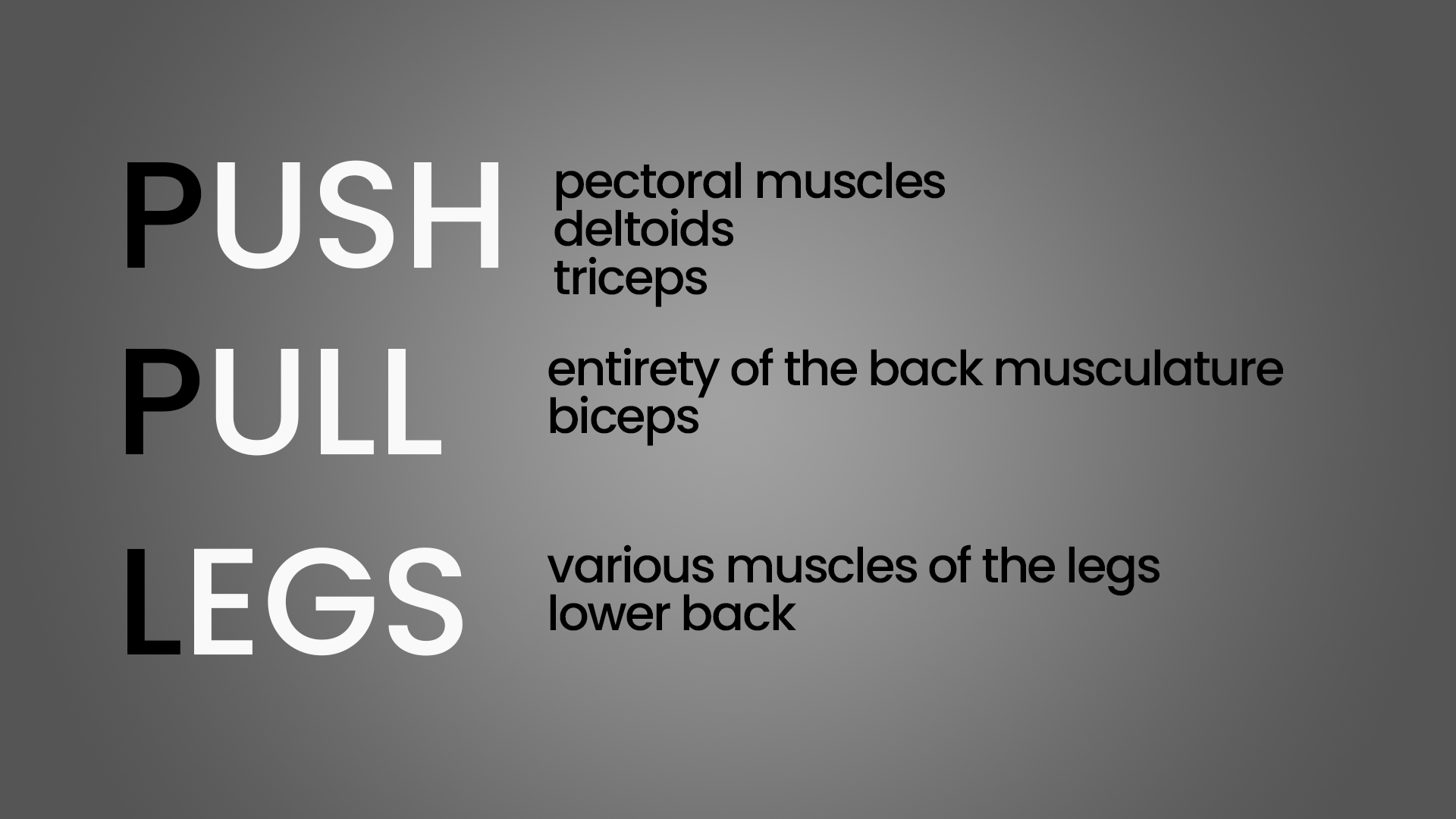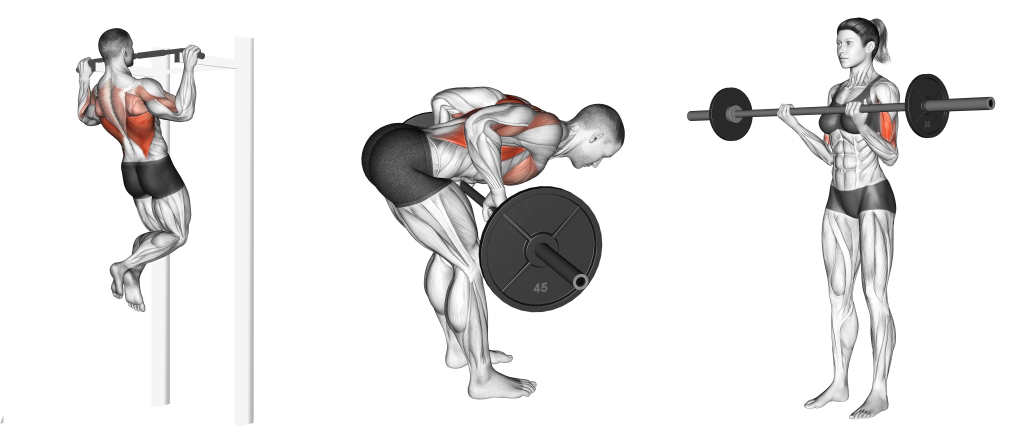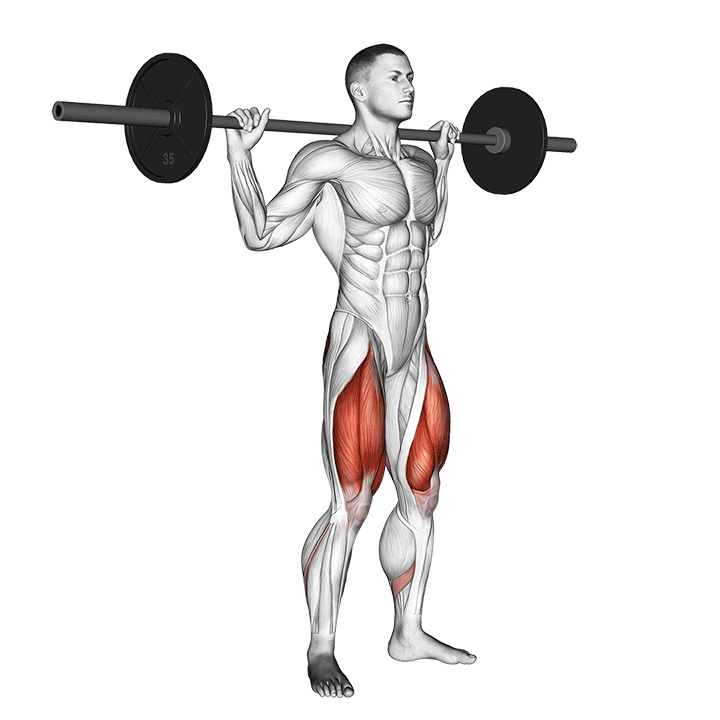Push Pull Legs (PPL) Program: 3 and 6 Day Split Examples
Push/pull/legs or PPL is a hybridized weightlifting program characterized by its unique usage of muscle force direction to split up training sessions.
Being one of the most popular training routines among bodybuilders and powerlifters alike, PPL has inspired several variations and modifications to better meet the needs of individual lifters.
In its most basic form, the push/pull/legs training split separates individual workouts by the direction in which they exert force. This means that antagonist upper body muscles like the triceps and biceps are trained in separate sessions, with the entire lower body being trained in a single workout.
What is a Training Program?
A training program is simply the predetermined routine that an exerciser follows as they train for a specific goal.
This can be something strict and highly specific like competitive rowing training, or something more generalized and wide-reaching, like an exercise program designed to improve a patient’s resting heart rate.
Within the context of resistance exercise, a training program will often be a long-term strategy that outlines what specific exercises are performed within a given workout, when and how many workouts occur within a time frame, and the rate at which the lifter will progress.
Training Programs In Regards to PPL
Push/pull/legs or PPL is one such resistance training program, and is considered to be simplistic enough to meet the needs of most non-competitive weightlifters.
If so desired, it may be modified by increasing the number of workouts within a week, or by altering what sort of exercises are performed within each workout session.
Changes to the default PPL program are done so as to make the program meet specific training needs, although advanced lifters will often switch to more complex training programs so as to continue progressing.
What is Push/Pull/Legs, And Why Should You Use it?
Push/pull/legs is a resistance training program featuring a unique split of muscle groups.

Muscles like the deltoids, pectorals and triceps are trained on push day, whereas the muscles of the back and biceps are trained during pull day; Of course, the muscles of the legs are trained on leg day.
The reasoning behind splitting up the muscles by their force direction is simply to avoid excessive fatigue, and to allow for greater volume to be placed on each individual muscle within their designated workout day.
Depending on the variation used, PPL may train the muscles up to a frequency of twice a week - although the traditional three day split will only do so once a week.
Each workout session will usually take up to an hour to complete.
Who Should Do Push/Pull/Legs?
Push/pull/legs was originally intended to be an intermediate-level program, but may easily be modified so as to make it suitable for novices as well. In truth, PPL is suitable for lifters of all levels - so long as it is subsequently changed to meet their specific goals.
However, note that novice lifters may progress more quickly from training programs that feature a muscle training frequency of three times a week instead.
What Kind of Training is Push/Pull/Legs?
Push/pull/legs is often referred to as “powerbuilding” due to the moderate volume and frequency that is performed, and the fact that it may be used for developing both muscle mass and strength simultaneously.
Of course, it is ultimately up to the lifter whether PPL will trend towards greater volume and thus hypertrophy, or greater resistance and thereby better strength development.
Is Push/Pull/Legs Better for Bulking or Cutting Diets?
Because of the frequency and volume involved, PPL is more suitable for bulking or maintenance diets - individuals in a caloric deficit may have trouble recovering properly, and should dial back the volume if they wish to stick with PPL as their program.
What Exercises Does Push/Pull/Legs Use?
Though the specific exercises of each PPL variation will vary by training needs and individual preference, a few exercises (primarily compound ones) are a staple in certain workout days.
Because of the sheer number of isolation exercises that may be performed in each individual workout, it is better to base each training program around one or two staple compound exercises, and to program the accessory movements after.
Best Push Day Exercises
Because push day trains the muscles of the chest, triceps and shoulders, the most common push day exercises are the bench press, the military press and the dip.

Best Pull Day Exercises
Pull day workouts train the muscles of the back and biceps, and will often include exercises like pull-ups, rows and curls.

Depending on the lifter’s goals, deadlifts may also be done on pull days, rather than leg days.
Best Leg Day Exercises
Muscles like the quadriceps, core, hamstrings and glutes are trained during leg day.

Unequivocally, leg day workouts involve some variation of the squat, and may also include exercises like the deadlift and leg press as well.
What are the Benefits of Push/Pull/Legs?
In comparison to other training programs, PPL presents several advantages relating to its highly efficient split methodology and general simplicity of programming.
Synergistic Muscle Split
The majority of compound resistance exercises follow much the same pattern as PPL - rarely will an exercise target the deltoids but not the triceps, for example.
As such, PPL is arguably one of the most “natural” and easy methods of splitting up a training program - and makes picking the right compound exercises relatively simplistic, as well.
Greater Capacity for Recovery
Because PPL features at least two days of recovery between each workout of the same muscle groups, recovery is maximized.
Not only will this reduce the risk of overtraining and injury, but it will also result in far greater muscular growth as the body is allotted sufficient time to build itself back up after each workout.
To get the most out of PPL, a proper diet and the correct selection of exercises is ideal.
Highly Variable Exercise Selection and Training Frequency
Because of how simple PPL’s split is, the number of exercises a lifter may choose from is quite significant.
So long as the exercise may be classified as a “push” or “pull” exercise, it can likely fit into PPL’s routine.
In addition, lifters are left with the choice of up to a 2x per week training frequency, allowing for up to six workouts per week if so desired.
Builds Strength, Size and Technical Knowledge
PPL is traditionally considered to be a generalist or “powerbuilding” program due to its capacity to emphasize more than a single aspect of muscular development.
Be it greater muscle mass, stronger force output or even technical familiarity with certain exercise mechanics, PPL is excellent among training programs.
How to Program and Modify Push/Pull/Legs
All forms of training program require a level of modification to better suit the exerciser - especially PPL, with its relative simplicity and ease of modification. Lifters may choose to focus more on a certain aspect of resistance training, and as such should be reflected in their program as well.
Change Compound Volume
While there is no doubt that compound exercises are vital to proper resistance training, individuals seeking hypertrophy over strength may wish to reduce the amount of compound volume in their workouts in favor of more isolation work.
This is especially true for large muscle groups that are regularly limited by fatigue in smaller muscle groups, like the glutes, pectorals or latissimus dorsi. Adding an extra isolation movement to target these muscles will help elicit a hypertrophic response.
Conversely, strength-focused lifters may wish to increase the number of compound exercise sets, thereby providing more practice with particularly heavy lifts.
Proper Exercise Selection
It goes without saying that lifters who wish to focus more on technical execution of powerlifting movements (or just strength development) should do more free weight compound exercises.
Furthermore, athletes may wish to include exercises into their program that better replicate movements taken during their specific sport. Basketball players may wish to perform more squat volume, and martial artists may wish to perform multiple core exercises.
Matching Frequency to Training Needs
Generally, there are two variations of PPL - the 3 day split and the 6 day split; As one may guess, the former only features 3 workouts a week, while the latter features 6.
In most cases, the 6 day split is considered to be the superior choice.
However, athletes who will also perform some sort of concurrent training (such as marathon training) will find that the 3 day split is easier to work around, and will generally result in less fatigue overall.
A 3 Day Push/Pull/Legs Split Sample
The 3 day variation of PPL is performed with each workout done consecutively, and with the following days either being for recovery or aerobic exercise.
Each exercise is listed as (total sets) and (repetitions), where each set is performed for the indicated number of repetitions.
Push Day
Barbell Bench Press 3 X 5
Dumbbell Overhead Press 3 X 8
Dumbbell Chest Flyes 2 X 12
Dumbbell Lateral Raises 2 X 12
Overhead Triceps Extensions 3 X 8
Pull Day
Barbell Row 3 X 5
Pull-Ups or Assisted Pull-Ups 3 X 8 or until RPE 9
Machine Lat Pulldowns 2 X 12
Dumbbell Shrugs 2 X 12
Dumbbell Bicep Curls 2 X 12
Leg Day
Barbell Back Squat 3 X 5
Barbell Deadlift or Barbell Sumo Deadlift 1-2 X 5
Machine Leg Extension 3 X 8
Machine Leg Curl 3 X 8
Calf Raises 2 X 12
Planks 2 sets, until failure
Is Just the 3 Day Split Enough?
Many lifters prefer the 6 day split over the 3 day split due to its insufficient frequency for maximum muscular development. The majority of weightlifters are more than capable of recovering within a 2 day period, and as such it is considered to be wasteful to only train the muscles once a week.
However, individuals with little time for training, or those who wish to avoid excessive training intensity will benefit quite well from the 3 day variation of PPL.
A 6 Day Push/Pull/Legs Split Sample
Unlike the 3 day variation, the 6 day variation allows for far greater freedom in workout emphasis, and can double the amount of training volume per week.
One may note, for example, that in the following sample program the “Leg Day A” and “Leg Day B” workouts feature two different primary compound exercises.
This is because the “A” leg day focuses more on the barbell squat, whereas leg day “B” focuses more on posterior chain training and the deadlift.
After the “A” set of workouts is completed, the lifter may choose to take a day of recovery before continuing with the “B” set, if so desired. Regardless, at least one day out of the week must be used for recovery, if not two.
Push Day A
Barbell Bench Press 3 X 5
Dumbbell Overhead Press 3 X 8
Dumbbell Chest Flyes 2 X 12
Dumbbell Lateral Raises 2 X 12
Overhead Triceps Extensions 3 X 8
Pull Day A
Barbell Row 3 X 5
Pull-Ups or Assisted Pull-Ups 3 X 8 or until RPE 9
Machine Lat Pulldowns 2 X 12
Dumbbell Shrugs 2 X 12
Dumbbell Bicep Curls 2 X 12
Leg Day A
Barbell Back Squat 3 X 5
Machine Leg Extension 3 X 8
Machine Leg Curl 3 X 8
Calf Raises 2 X 12
Planks 2 sets, until failure
Push Day B
Barbell Overhead Press 3 X 8
Dumbbell Chest Press 3 X 8
Dumbbell Rear Delt Flyes 2 X 12
Pec Deck Machine 2 X 12
Cable Tricep Pushdowns 2 X 12
Pull Day B
Weighted or Conventional Pull-Ups 3 X 8 or until RPE 9, 1 X AMRAP
Dumbbell Bent-Over Rows 3 X 8
Close-Grip Cable Rows 2 X 12
Dumbbell Hammer Curls 2 X 12
Incline Dumbbell Curls 2 X 12
Leg Day B
Barbell Deadlift or Barbell Sumo Deadlift 3 X 5
Leg Press Machine or Barbell Squats 3 X 8
Good Mornings 2 X 8
Barbell Hip Thrusts 3 X 12
Calf Raises 2 X 12
Hanging Leg Raises 2 X 12, 1 X AMRAP
Frequently Asked Questions (FAQ)
Is PPL for Men or Women?
PPL is suitable for both men and women, and is geared towards lifters of all experience levels as well.
Is a 6 Day PPL Split Too Much?
Not at all - so long as recovery and weekly volume are minded, it is unlikely that the 6 day PPL split will result in overtraining or injury.
Should Beginners do PPL?
Beginners benefit from a more rapid recovery than intermediate or advanced weightlifters, and as such may be better off performing a 3X per week full-body training split instead.
A few popular beginner programs are: Stronglifts, Rippetoe’s Starting Strength and Phrak’s Greyskull LP.
Final Thoughts
PPL is undoubtedly a solid training program, but it will require some tweaking in order to maximize its effectiveness.
Keep in mind that no two lifters are the same, and that if you find a particular exercise or repetition scheme uncomfortable, it is entirely fine to substitute it with one better suited to your needs.
And as always - proper form adherence is a must, regardless of training program or exercise.
References
1. Merritt, Greg. "Push-pull: train your muscles every third day with a push-pull workout split." Flex, November 2014, 58+. Gale Academic OneFile
2. Iversen, V.M., Norum, M., Schoenfeld, B.J. et al. No Time to Lift? Designing Time-Efficient Training Programs for Strength and Hypertrophy: A Narrative Review. Sports Med 51, 2079–2095 (2021). https://doi.org/10.1007/s40279-021-01490-1
